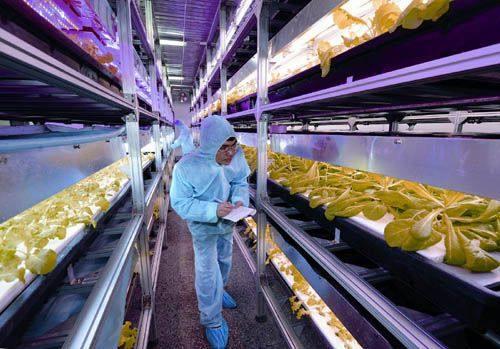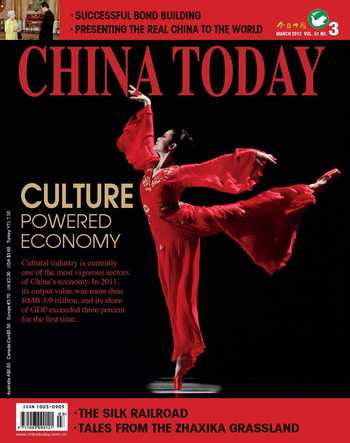Plant factories

OUR world is built on agricul- ture, the two basic requirements of which are arable land and stable weather. But a revolution waits just round the corner as agriculture is being separated from even these fundamentals. Soon the harvest of cereals and vegetables might be entirely independent of soil, seasons or rainfall as “plant factories” open their doors for business. The technology is here today, and the first large-scale plant factory in China has already started seeding its magic in Tongzhou District, Beijing.
Plant factories are considered the big next step in the industrialization of agriculture. Biological, agricultural, computing and mechanical automation technologies are used to increase the quantity and quality of the produce“manufactured” in these factories. There are high hopes this technology will aid in bringing agriculture to previously non-arable locales such as deserts, barren islands, water surfaces, the Polar Regions and even our homes.
Currently, excluding China, only a few developed countries such as Japan, the United States and the Netherlands possess the technological know-how to make the deserts, or rather factories, bloom.
The Beijing plant factory started life as a research project funded by the Beijing Municipal Science and Technology Commission. The factory itself was developed and designed with the aid of the Beijing Agricultural Machinery Institute and its subsidiary, the Beijing Kingpeng International High-tech Corporation. It is a world-leader in factory-based plant growth technology and equipment. “We have mastered the core technology and have the intellectual property rights,”said Tian Zhen, director of the Beijing Agricultural Machinery Institute.
From a distance, the glass and steel structure looks more like a futuristic aircraft than a factory. Inside, all fruit trees, vegetables and flowers grow in nutrient fluid rather than soil. Temperature, moisture, lighting, carbon diox-ide concentration and air currents are electronically controlled. The growth of crops is monitored and automatically regulated by the factorys computers. Even the fruits and vegetables shape and taste can be altered. Microchips installed in the growing areas send live information to employees about plants progress in their growing cycle.
In one seedling cultivation chamber, 5,000-6000 lettuce seedlings can be grown in one square meter. This represents an area output 10 times that of the most ideal natural environment. Thanks to stack trays that allow plants to grow at differing vertical levels, the operating surface of each chamber can be increased to multiples of its floorage. This result is a cultivatable area per square meter far greater than land could ever manage.
All living things eventually depend on the sun for growth and nutrients. At the plant factory in Tongzhou, plants grow under sunlight as well as artificial light that comes primarily from LEDs installed above growing areas.
Solar power is also used in the factory to provide low-carbon green energy.“We have a 15 kW photovoltaic power generation system, so the key parts of the factory can function normally in the event of disruptions to the normal electricity supply. Batteries ensure a steady light supply even after three days of rain, fog or snow,” said Zhou Zengchan, chief engineer of Beijing Kingpeng International High-tech Corporation.
As the crops growing environment and progress can be controlled by employees, fruits and vegetables are grown and harvested in cycles for several seasons in a row. The process from sowing to harvest takes a mere 20 to 30 days, over 30 percent quicker than regular growth. Ripe produce is harvested, packaged by automated robots according to customers specifications and stored in refrigerated warehouses before hitting the market.
When operating at full capacity, the Beijing plant factory can produce an annual harvest of high quality vegetables and fruits grown from 15 million seedlings obtained through machine sowing and 100,000 through tissue culture. Cheng Cunren, who, as deputy director of the Beijing Agriculture Machinery Institute, participated extensively in the design of the factory, says different types of plant factories will be designed in the future to meet the specific demands of varying markets, regions and people.
More good news for the average consumer is that the factory has managed to develop a refrigerator-esque plant micro-factory for household use. In the near future, families will be able to grow“smart gardens” in their own homes.
The Tongzhou factory provides a clean, pest-free environment for all crops and as such there is no need for insecticides in the growing process. Its fruit and vegetable produce is as natural as can be. Factory representatives say even washing before consumption is unnecessary.
The Beijing crop factory is not the only such operation changing the future of agriculture in China. A few years ago, as the earliest LED-lit plant factory technology was developed at the Institute of Agricultural Environment and Sustainable Development of the China Academy of Agricultural Sciences, a small-scale factory proto-type started operations at the Changchun Agricultural Expo Park in northeast Chinas Jilin Province.
According to Yang Qichang, a research fellow with the institute, while plants are exposed to all spectra of sunlight, experiments have demonstrated that the wavelengths most absorbed by plants (60 percent) are those we see as red and blue. “An artificial light source containing the right mix of red and blue rays can meet plants sunlight needs without affecting their quality,” says Yang.
Plant factory technology is moving forward rapidly. Another factory was opened in October 2011 at Anzhen Agricultural Science & Technology Park in Wuxi, Jiangsu Province. Operators of this new“plant” have installed film insulation to growing areas that acts as insecticide and greatly reduces the already slim possibility of its produce suffering at the mandibles of insects and bacteria. The future of agriculture looks bright, green and has a factory sheen in China.


